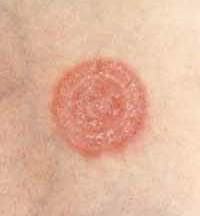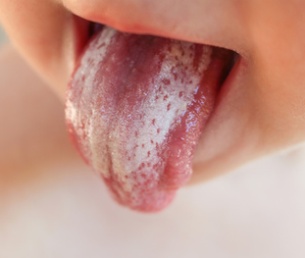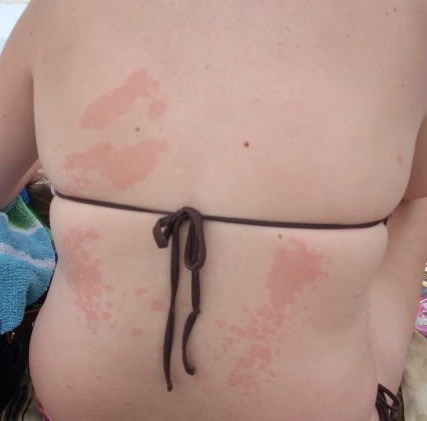Skin disease caused by fungus is more common than you might think and many types of skin fungus are quite easy to pick up. We’ll tell you about some of the more common types of fungal infections, including typical symptoms. Most fungal infections of the skin are fairly easy to treat, although you should know that these infections will not clear up without treatment and they may get worse over time or spread to other areas of the body if you don’t get proper treatment. We will try to provide you with the information you need about skin fungus, but as always, if you have something going on with your skin and you aren’t sure what it is or how to treat it, see your doctor for medical advice.
Ringworm

Ringworm is a common skin disease caused by fungus. It’s not really a worm at all, but a fungal infection of the skin. It’s called ringworm because of its appearance. It often causes a raised ring on the skin that resembles a worm. The area may be red or scaly. Ringworm can be itchy and it spreads easily to others. It can occur anywhere on the body, including hands, torso, legs, or on the scalp, where it can cause hair loss.
Athlete’s Foot
As mentioned above, you can get ringworm on any part of the body. When it occurs on the feet, it is often referred to as athlete’s foot (although the medical term for it is tinea pedis). That’s because it is often picked up in locker rooms, where people walk around barefoot on warm, damp floors. The skin on the feet may get red and scaly, especially between the toes. Athlete’s foot can itch or even be painful, especially if sores develop on the feet, which sometimes happens. Here is information on treating athlete’s foot.
Jock Itch
It is also possible to get ringworm in more sensitive areas, like the groin. That is often referred to as jock itch, since it is common in people that sweat a lot, like athletes, and it can be very itchy. The medical term for it is tinea cruris. Both men and women can get tinea cruris, and according to the Mayo Clinic, it can affect the inner thighs and buttocks as well as the groin. In some people, it can become a chronic condition.
Candidiasis

A very common type of skin disease caused by a fungus, candidiasis is often referred to as a yeast infection. Yeast is a type of fungus and it naturally lives on our skin and mucous membranes. Sometimes the fungus begins to grow out of control, however. Candidiasis is often caused by the use of antibiotics, which can kill off beneficial bacteria in our bodies as well as harmful bacteria. Killing the “good bacteria” can allow the yeast to grow unchecked. It can cause an inflamed scaly rash like a diaper rash on the skin. It can itch and may also cause an unpleasant odor.
Candidiasis can occur in the mouth and throat, where it is often referred to as thrush. Then you can usually see a thick whitish coating on the tongue and in the throat. It can also occur in the vagina, which is what women are often referring to if they mention having a yeast infection. Then it often causes a thick, whitish, or yellowish discharge.
Here is more information on candidiasis treatment.
Tinea Versicolor

Tinea versicolor is another of the many types of skin fungus. It’s a bit less common than candidiasis, though. Teenagers and young adults are most likely to get it because they tend to have oily skin. It’s also most common in very warm places, including tropical and subtropical climates. Like candidiasis, it’s caused by a type of yeast that normally lives on our skin but grows out of control. It causes discolored spots or patches on the skin. The spots can be white, red, pink, tan, or brown, and they may be lighter or darker than your normal skin tone. They may be dry and crusty. Tinea versicolor can be very itchy and many people are also concerned about how it looks. It can cover a significant part of the body.
Onychomycosis (Nail Fungus)
It is possible for fungus to infect the fingernails or toenails. Affected nails may appear dull or yellowish, brown or even black in color. They usually appear thicker than normal and maybe crumbly. The fingertips or tips of the toes may be sore and there may be an unpleasant odor from the nails. Here is more on treating nail fungus.
Dermatophytid Reaction
A dermatophytid reaction is not exactly a skin disease caused by a fungus, but an allergic reaction to fungus on the skin. It’s an unusual sort of allergic reaction because the reaction is seen in a different area from the area affected directly by the fungus. For instance, a dermatophytid reaction might cause itchy red bumps to appear on your hands and fingers when you have an athlete’s foot caused by a fungal infection of your feet.
Mayo Clinic: Jock Itch
